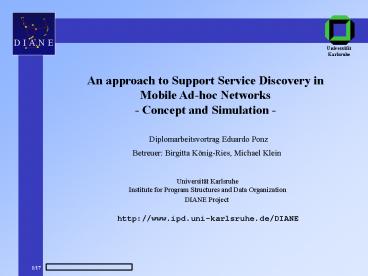DIANE Project - PowerPoint PPT Presentation
1 / 17
Title:
DIANE Project
Description:
Mobile devices are becoming very popular ... Service Ring Model. Service Ring (2) ... . 17 /17. Thank you! More information on our project web page: ... – PowerPoint PPT presentation
Number of Views:27
Avg rating:3.0/5.0
Title: DIANE Project
1
Universität Karlsruhe
An approach to Support Service Discovery in
Mobile Ad-hoc Networks - Concept and Simulation -
Diplomarbeitsvortrag Eduardo Ponz
Betreuer Birgitta König-Ries, Michael Klein
Universität Karlsruhe Institute for Program
Structures and Data Organization
DIANE Project
http//www.ipd.uni-karlsruhe.de/DIANE
2
Introduction
- Mobile devices are becoming very popular
Introduction
Scenario
Concept - Information - Protocols
Implementation
Summary
- We want to link these devices in mobile ad-hoc
networks and offer services
- How do we search for a service in such a network?
3
Problems with Mobile Ad-hoc Networks
Introduction
Scenario
Concept - Information - Protocols
Implementation
Summary
- Highly dynamic topology due to
- - node movement
- - node fluctuation
- - appearing obstacles
- No dedicated server, no physical infrastructure
4
Service Ring (1)
DIANE Approach Service Rings
Introduction
- Group nodes offering similar services into a
Service Ring (SR)
Scenario
Concept - Information - Protocols
Implementation
Summary
- One node of the ring becomes the Service Access
Point (SAP)
- This node has the description of all the
services of the ring
5
Service Ring (2)
Many aspects have to be considered in the service
ring model
Introduction
Scenario
Concept - Information - Protocols
- Service description
- Service discovery
Implementation
Summary
- Service integration
- Motivation
6
Service Discovery
Service discovery implies many different aspects
Introduction
Scenario
- Ring and Service Information
- - What information should be stored in the nodes?
Concept - Information - Protocols
- Initialization Protocol
- - How is a service ring built?
Implementation
Summary
- Node Routing Protocol
- - How do we find the proper service inside a
service ring?
- Ring Routing Protocol
- - How do we find the proper service ring?
- Actualization Protocol
- - How should the system react to device movement
and fluctuations?
7
Ring and Service Information
Information about the service ring has to be
locally stored in the nodes
Introduction
Scenario
Concept - Information - Protocols
Implementation
Summary
- Service Information
- Services offered by the node
8
Initialization Protocol
How to build a service ring from scratch
Introduction
- One node appears
Scenario
SAP
Concept - Information - Protocols
- A second node appears
- A third node appears
Implementation
Service Ring?
We ask if there is any SR nearby
SR?
Summary
SR?
9
Node Routing Protocol (1)
How to find the proper service inside a SR
Introduction
- Routing in a simple SR is trivial
but...
Scenario
Concept - Information - Protocols
No
Xs Successor
Service D?
Node X
Yes, but NOT me
- Each node has one successor and one predecessor
Implementation
Thanks!
Summary
Xs Predecessor
- We only have to route the message to the
successor node
YES
No
- How do we deal with intricate rings?
10
Node Routing Protocol (2)
Service rings may be intricate
Introduction
Scenario
Concept - Information - Protocols
C2
C4
Implementation
C1
Summary
C5
C3
- Some nodes have more than one successor and
predecessor
- Some nodes have twice the same successor or
predecessor
To properly route a message
- We divide the service ring into cycles
- A message traveling along the SR will keep
track of which cycles are already visited
11
Node Routing Protocol (3)
Example of routing a message
Routing complete!
Introduction
Service D?
Scenario
Concept - Information - Protocols
C2
C4
Implementation
C1
Summary
C5
C3
Algorithm for nodes with many successors
- Continue in the same cycle
- If we have twice the same successor - If the
other cycles have been partially visited
- Jump to another cycle
- If the other cycle is a not visited bridge - If
the other cycle is a not visited cycle
12
Ring Routing Protocol
How do we find the proper SR?
Introduction
Scenario
Concept - Information - Protocols
Implementation
Summary
The SAPs are connected with each other
- The SAPs store the information about ring routing
- A message can now jump to other SRs
13
Actualization Protocol (1)
Reactions to device movements and fluctuations
Introduction
Scenario
Concept - Information - Protocols
Implementation
Summary
Typical node fluctuations are
- Movement
- Into a SR
- Out of a SR
- Logging
- Login into a SR
- Logout of a SR
- Sudden disconnection
14
Actualization Protocol (2)
Example of sudden disconnection algorithm
Introduction
- Node B vanishes
Scenario
- Node A needs to link with C
Concept - Information - Protocols
C is not reachable!
F
A
Implementation
Summary
- Node C looks for reachable nodes
X
E
- Node C requests information
- Reachable nodes send info
- C processes the info and chooses the best node
C
D
- C sends control message to X
- X marks C as successor
Note Backward routing should be only used if
everything else fails
- X sends control message to A
- A marks X as successor
- The SR is successfully closed
15
Implementation
A simulation of the Node Routing Protocol in a
service ring is currently under development
Introduction
Scenario
Concept - Information - Protocols
- QualNet is the network simulator used for this
purpose
Implementation
Summary
- QualNet models complex wireless networks
- There are pre-written protocol models
- Custom protocols can be developed
16
Summary and Future Work
Summary
Introduction
- A basic mechanism to service discovery has been
proposed
Scenario
Concept - Information - Protocols
ü
Implementation
ü
Summary
ü
ü
ü
Future Work
- Optimization to the proposed protocols
- Implementation of all the protocols in QualNet
- Prototype in a real scenario
17
Thank you!
Thank you for your attention!
More information on our project web
page http//www.ipd.uni-karlsruhe.de/DIANE































